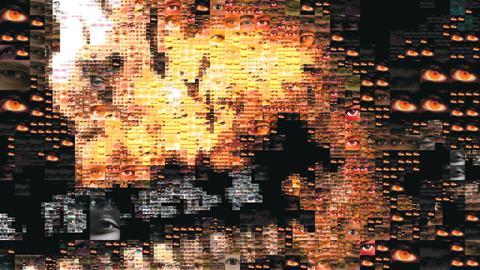
‘DISASTER MOVIE EYES’ Still from video, 2012, by Reese Inman. |
For many artists digital and analog image-capture and production seem to force a choice. Reese Inman merges the two, creating hybrid artworks that explore the mutability of information. A recent graduate of the University of Maine's Intermedia MFA Program, Inman seems equally at home with paint and computer. Her exhibition, "Analog/Digital," at the University of Maine at Augusta consists of 21 paintings and three videos, which powerfully interplay and provide context for each other. Among oppositional themes suggested by the pairing, physical touch and immaterial technology seem the most obvious. Aesthetically though, paintings and videos are both built up of incremental components, not dissimilar to bytes of information.
In purely descriptive terms, Inman's "Algorithm Map Paintings" contain colorful dots in various configurations on monochrome or slightly modulated backgrounds. They are hand-made recreations based on snapshots or printouts of computers running algorithms. Each colored dot is rendered with a drop of paint; repeated painting and sanding result in fields of raised dots or lozenge-like shapes surrounded by more or less discernible rings of colors.
Like pointillist abstractions, the paintings range in mood from baroque opulence in "Remix VI" (2009), to the flare of digital code streaming over a screen in "Isoltantalus III" (2006). In fact, the gallery can feel like a control room in some computer center with screens flickering all around, but the color palettes of dots and backgrounds are strikingly nuanced and beautiful. The accumulation and distribution of dots is greatly but sometimes subtly varied. Some paintings evoke nocturnal aerial views of urban areas, like topographies of light. None of them read like outtakes of a larger matrix, as the compositions perfectly honor the edges of the panels. Occasional flaws in execution where dots have merged to form irregular shapes are welcome disruptions of same-ness and indicators of the hand-made.
What is the subject of these paintings? If it is contained in the algorithms of dots, it has become inaccessible and only serves as a pretext for the exploration of the generative area between analog and digital, handmade and machine-generated, original and copy.
Inman's three videos are part of her "Video Remapping Project," which I find conceptually more interesting than the paintings. She developed software that essentially overlays one set of parameters with another, obscuring the meaning of both. The videos' imagery is made up of a collection of still images of eyes, flowers, and video-game characters that replaces film footage of disaster movies, Times Square, and nature scenes from the Discovery Channel. Just like every digital image breaks down into pixels, "Disaster Movie Eyes," "Times Square Garden," and "Discovery Channel Super Mario" are comprised of standardized units of images. Viewers look at nothing but eyes, flowers, and graphic icons in rapid-fire succession — it is their relative size, color, and constant change that suggest larger imagery to us. Remnants of visual meaning become discernible only from a distance in an endless oscillation between representation and abstraction, between recognizability and illegibility.